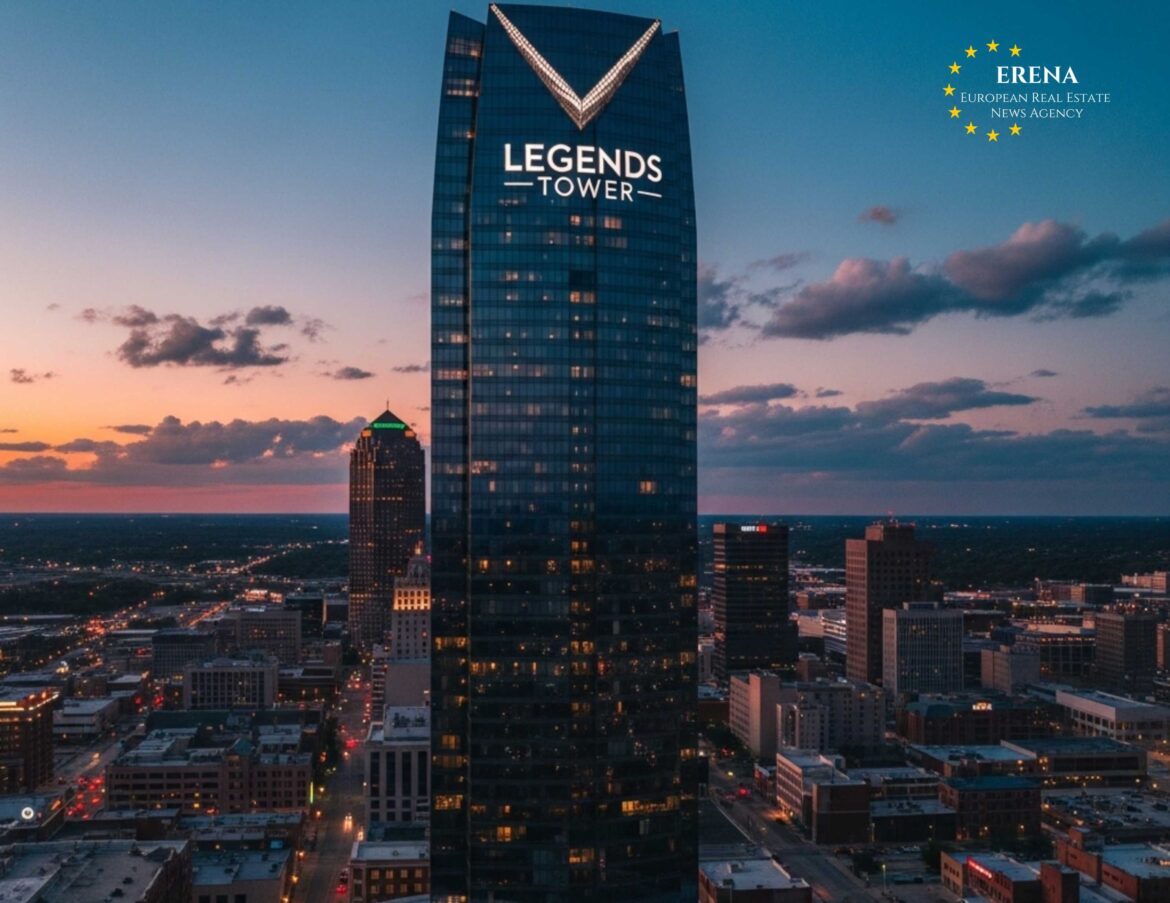The proposed Legends Tower in Oklahoma City could reshape the hierarchy of American skyscrapers. With a planned height of 1,907 feet (581 meters), it is set to surpass New York’s One World Trade Center and claim the title of tallest building in the United States. The project is slated for completion by 2030 and has already received crucial permits and financial backing.
Key Features of the Project
Legends Tower will be the centerpiece of the large-scale Boardwalk at Bricktown development. The tower will rise 134 stories and include residential apartments, hotel rooms, retail space, offices, and restaurants. The height of 1,907 feet was deliberately chosen to commemorate the year Oklahoma became a U.S. state — 1907.
The complex is located in the Bricktown neighborhood, replacing existing parking and warehouse facilities. In addition to Legends Tower, the project includes three shorter towers at 345 feet each, as well as canal restoration, pedestrian promenades, a marina, shopping galleries, and a new arena for the Oklahoma City Thunder.
Architecture and Engineering
The building is designed by California-based architecture firm AO, with engineering support from Thornton Tomasetti. The structure takes into account Oklahoma’s tornado-prone climate and wind load risks. Plans call for a reinforced concrete core, steel frames, vibration dampers, and energy-efficient systems.
A panoramic restaurant and observation deck will occupy the top levels. The tower will integrate sustainable technologies such as solar panels, rainwater harvesting, high-performance glass, and LEED certification.
Financing and Approvals
The total project cost is estimated at $1.5 billion, with approximately $770 million dedicated to Legends Tower alone. Funding is being secured through private investment with support from city authorities.
In 2024, the project cleared several critical hurdles. The Federal Aviation Administration (FAA) approved the tower’s planned height, removing airspace restrictions. Zoning laws were also adjusted to allow “unlimited height,” paving the way for the ambitious design.
Functional Layout
The tower will feature 1,776 residential units, a 350-room Hyatt hotel, over 110,000 square feet of retail and dining space, offices, and event venues. The ground floors will host cafés, boutiques, and leisure facilities. Housing will be available for both sale and long-term rent, including subsidized units for young professionals.
The development will be integrated with the city’s transport network, offering underground parking, EV charging stations, bike routes, and canal access.
Economic and Social Impact
The construction and operation phases are expected to create thousands of jobs, including hotel staff, retail employees, and maintenance teams. City officials anticipate increased tax revenues, tourism growth, and broader investment appeal in downtown Oklahoma City.
The observation deck is expected to attract millions of annual visitors, boosting the city’s profile nationwide and supporting local hospitality businesses.
Market Reactions and Concerns
Despite widespread enthusiasm, some skepticism exists. Architects have questioned the feasibility of such a tall structure in a city with lower density and limited high-end housing demand. The FAA had previously expressed concerns regarding air traffic disruptions due to the tower’s height.
Mayor David Holt took a neutral stance, saying that not all megaprojects come to life, but the ambition behind this one reflects Oklahoma City’s growing aspirations.
Comparison with Other Buildings
If built as planned, Legends Tower would surpass One World Trade Center (1,776 feet) to become the tallest building in the United States. Globally, it would rank in the top 10, behind Burj Khalifa (828 meters), Merdeka 118, Shanghai Tower, and others.
The project is not just about height — it’s a transformative statement. It demonstrates that skyline-defining architecture is no longer limited to coastal megacities.
Timeline and Construction Phases
Construction is expected to begin in 2026. Initial efforts will focus on the lower towers and infrastructure, with Legends Tower following in subsequent phases. The full buildout is scheduled to complete by 2030, depending on market stability, material costs, and regulatory conditions.
Conclusion
The Legends Tower project marks a bold leap in regional architecture and urban development. It is more than just a building — it’s a symbol of Oklahoma City’s ambition to step onto the national and global stage.
If successfully executed, the tower will redefine the skyline of the American Midwest and challenge traditional assumptions about where world-class architecture belongs. Combining cultural symbolism, cutting-edge engineering, and economic revitalization, Legends Tower could soon rise as a vertical emblem of a city on the rise.

